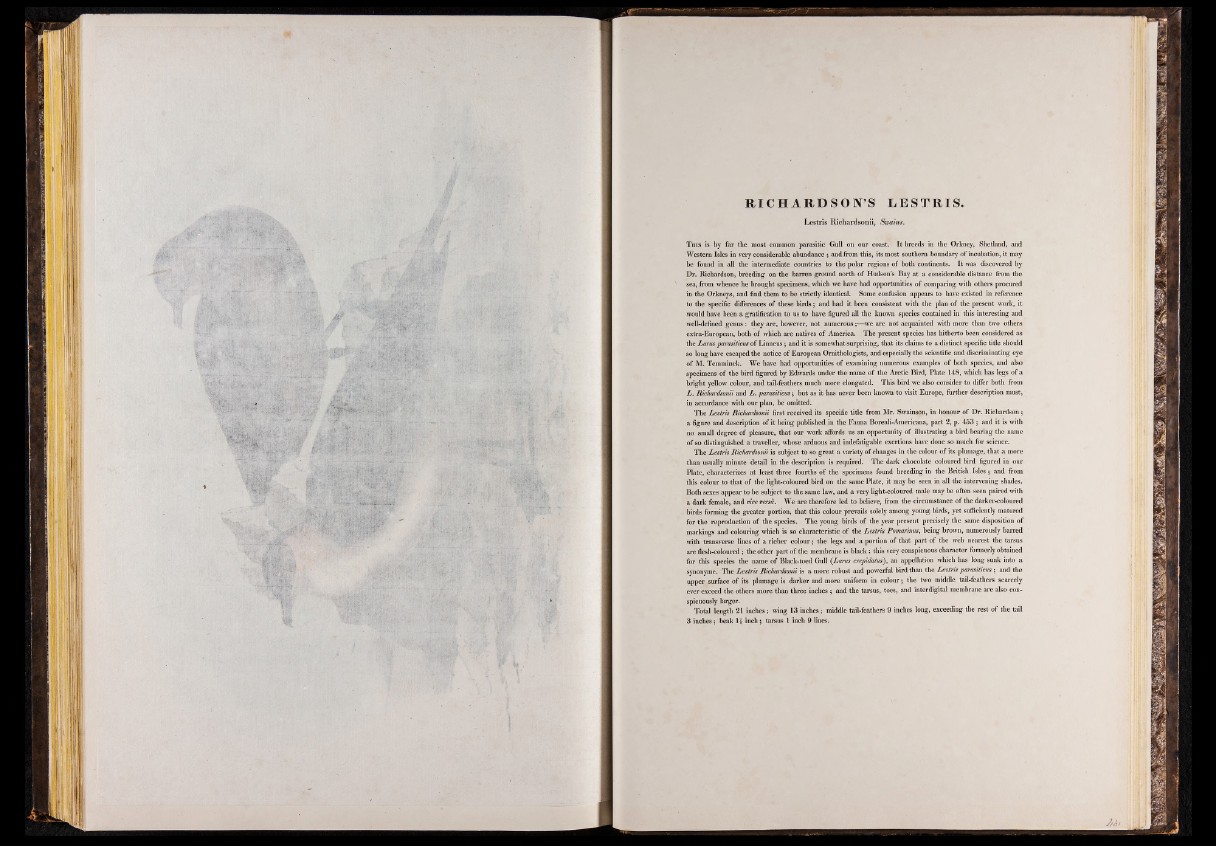
I
.'-SC'S#-
R IC H A R D S O N ’S LESTRI S .
Lestris Richardsonii, Swains.
T his is by far the most common parasitic Gull on our coast. It breeds in the Orkney, Shetland, and
Western Isles in very considerable abundance ; and from this, its most southern boundary of incubation, it may
be found in all the intermediate countries to the polar regions of both continents. It was discovered by
Dr. Richardson, breeding on the barren ground north of Hudson’s Bay at a considerable distance from the
sea, from whence he brought specimens, which we have had opportunities of comparing with others procured
in the Orkneys, and find them to be strictly identical. Some confusion appears to have existed in reference
to the specific differences of these birds; and had it been consistent with the plan of the present work, it
would have been a gratification to us to have figured all the known species contained in this interesting and
well-defined genus : they are, however, not numerous;—we are not acquainted with more than two others
extra-European, both of which are natives of America. The present species has hitherto been considered as
the Lams parasiticus of Linneus; and it is somewhat surprising, that its claims to a distinct specific title should
so long have escaped the notice of European Ornithologists, and especially the scientific and discriminating eye
of M. Temminck. We have had opportunities of examining numerous examples of both species, and also
specimens of the bird figured by Edwards under the name of the Arctic Bird, Plate 148, which has legs of a
bright yellow colour, and tail-feathers much more elongated. This bird we also consider to differ both from
L . Richardsonii and L . parasiticus; but as it has never been known to visit Europe, further description must,
in accordance with our plan, be omitted.
The Lestris Richardsonii first received its specific title from Mr. Swainson, in honour of Dr. Richardson;
a figure and description of it being published in the Fauna Boreali-Americana, part 2, p. 453; and it is with
no small degree of pleasure, that our work affords us an opportunity of illustrating a bird bearing the name
of so distinguished a traveller, whose arduous and indefatigable exertions have done so much for science.
The Lestris Richardsonii is subject to so great a variety of changes in the colour of its plumage, that a more
than usually minute detail in the description is required. The dark chocolate coloured bird figured in our
Plate, characterizes at least three fourths of the specimens found breeding in the British. Isles ; and from
this colour to that of the light-coloured bird on the same Plate, it may be seen in all the intervening shades.
Both sexes appear to be subject to the same law, and a very light-coloured male may be often seen paired with
a dark female, and vice versa. We are therefore led to believe, from the circumstance of the darker-coloured
birds forming the greater portion, that this colour prevails solely among young birds, yet sufficiently matured
for the reproduction of the species. The young birds of the year present precisely the same disposition of
markings and colouring which is so characteristic of the Lestris Pomarinus, being brown, numerously barred
with transverse lines of a richer colour; the legs and a portion of that part of the web nearest the tarsus
are flesh-coloured ; the other part of the membrane is black: this very conspicuous character formerly obtained
for this species the name of Black-toed Gull (Lams crepidatus'), an appellation which has long sunk into a
synonyme. The Lestris Richardsonii is a more robust and powerful bird than the Lestris parasiticus; and the
upper surface of its plumage is darker and more uniform in colour; the two middle tail-feathers scarcely
ever exceed the others more than three inches ; and the tarsus, toes, and interdigital membrane are also conspicuously
larger.
Total length 21 inches; wing 13 inches; middle tail-feathers 9 inches long, exceeding the rest of the tail
3 inches; beak 1& inch; tarsus 1 inch 9 lines.
JiJn